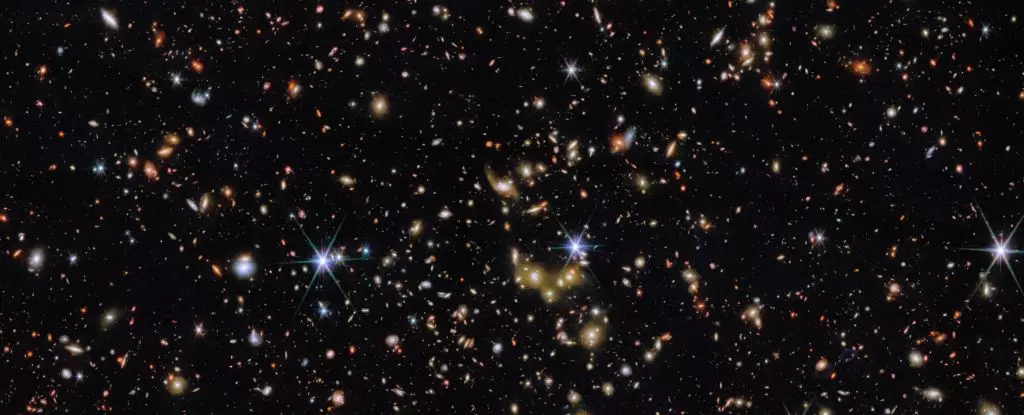Every so often, advancements in technology propel us into realms of understanding that both astonish and humble us. The recent deep field image captured by the James Webb Space Telescope (JWST) aptly demonstrates this phenomenon. Gazing into a minuscule section of the sky—less than one-fifth the width of a full Moon—this groundbreaking image reveals a bustling cosmos filled with light. However, these lights are not the familiar twinkling of stars we admire from Earth on a clear night; rather, they represent galaxies, each one a vast city of stars, gas, and dust. The image reaches back nearly 12 billion years, offering a glimpse of an era not long after the birth of the Universe itself, an undeniably humbling reminder of our place in this grand expanse.
The Artistry of JWST’s Imaging
One of the first things that attracts the viewer’s eye in the JWST image is its striking visualization—the bright, pointy diffraction spikes marking individual stars juxtaposed against the softer glow of distant galaxies. This distinctive pattern is the result of how the telescope’s optics process light, allowing astronomers to discern foreground stars from the faint glow of background galaxies. Herein lies not only a technological marvel but a visual testament to the intricacies of cosmic observation. Each galaxy glimmering in the background represents a unique historical narrative, with light that has traversed incomprehensible distances across time. Such distinctions foster a deeper appreciation for the Universe, transcending mere fascination to evoke heartfelt wonder.
Understanding the Cosmic Web
What’s particularly compelling about this new imaging is its contribution to our understanding of galactic structures. The focus lies on a luminous group of galaxies just below the image’s center, shining with an ethereal golden hue. This cluster, which has taken over 6.5 billion years to reach us, is crucial for the COSMOS-Web survey—a groundbreaking initiative aimed at cataloging galaxies to provide clarity on their formation and distribution. Astrophysicists hypothesize that galaxies are not just scattered randomly across the cosmos; their arrangement forms a cosmic web, interconnected through invisible strands of dark matter and hydrogen. The revelation that galaxies cluster in this manner brings an ordered narrative to the seemingly chaotic nature of the Universe.
The Scale of Discovery
To underscore the significance of this research, an international team of astronomers led by Greta Toni of the University of Bologna has cataloged an astounding 1,678 groups of galaxies within this seemingly ordinary patch of sky. This is not merely a count of discrete galaxies but rather a testament to galactic communities—clusters that collectively contain vast numbers of stars. The implications of finding so many galaxies in such a small area of the sky challenge preconceived notions of cosmic emptiness and emphasize the richness and abundance of celestial matter. If this tiny patch is teeming with such a plethora of galaxy groups, one can only imagine the staggering numbers that would arise from surveying other minuscule sections of our night sky.
The Chandra X-ray Connection
Compounding this visual spectacle, observations with the Chandra X-ray Observatory drastically enhance our understanding of these galactic clusters. The hot gas that suffuses these groups emits X-rays strong enough for Chandra to detect, revealing the immense mass and structure of the galaxy clusters. This combination of data not only validates previous assumptions regarding dark matter’s influence on galactic formation but also provides a more nuanced understanding of the dynamics at play within the cosmic fabric. Each galaxy is a part of a larger picture, feeding into a grand narrative about the Universe’s evolution.
A Call to Cosmic Humility
Ultimately, the latest JWST findings serve as a powerful reminder of our curiosity and thirst for knowledge. While we continue to push the boundaries of what we know, each image underscores our smallness in the vast cosmic arena. The realization that even the smallest slivers of our sky harbor such wealth of information ignites a sense of wonder, inviting us to ponder the mysteries that still lie beyond our reach. The Universe, with its boundless galaxies, both beckons and humbles, reminding humanity of its delicate place within an infinitely complex and awe-inspiring cosmos.

